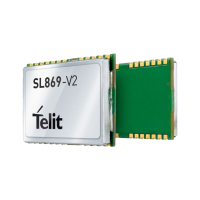4.3.1. SBAS Corrections
The SBAS satellites transmit a set of differential corrections to their respective regions.
The use of SBAS corrections can improve positioning accuracy.
Differential GPS (DGPS) (SL869L-V2 and SL869L–V2S only)
DGPS is a Ground-Based Augmentation System (GBAS) for reducing position errors by
applying corrections from a set of accurately surveyed ground stations located over a
wide area. These reference stations measure the range to each satellite and compare it
to the known-good range. The differences can then be used to compute a set of
corrections which are transmitted either by radio to a DGPS receiver or over the internet.
The DGPS receiver can then send them to the module 2
nd
serial port (RX2) using the
RTCM SC-104 protocol message types 1, 2, 3, and 9.
These corrections can significantly improve the accuracy of the position reported to the
user.
The receiver can accept either the RTCM SC-104 messages or SBAS differential data via
command PMTK501.
Assisted GPS (AGPS)
Assisted GPS (or Aided GPS) is a method by which TTFF is improved (reduced) using
information from a source other than broadcast GPS signals.
The necessary ephemeris data is calculated either by the receiver itself (locally
generated ephemeris), or a server (server-generated ephemeris) and stored in the
module.
Please refer to section 2.3 Product Variants for applicability.
4.5.1. Locally generated AGPS - Embedded Assist System (EASY)
This feature is not supported on the SL869-V2S until ROM MT3337E version (enhanced)
of Oct 2015. It is supported on the SL869L-V2S.
Proprietary algorithms within the module perform GPS ephemeris prediction locally from
stored broadcast ephemeris data (received from tracked satellites). The algorithms
predict orbital parameters for up to three days. The module must operate in Full Power
mode for at least 5 minutes to collect ephemeris data from visible satellites, or 12 hours
for the full constellation.
EASY is disabled if the fix rate is > 1 Hz

